Here’s something that’s hard to find: An electric version of a car that costs less – at least to start – than the engine’d version of the same car.
That would be the Mercedes EQS.
But there might be a reason for that . . .
What It Is
The EQS is essentially an electrified S-Class sedan, which is Mercedes’ top-of-the-line (and full-size) luxury sedan.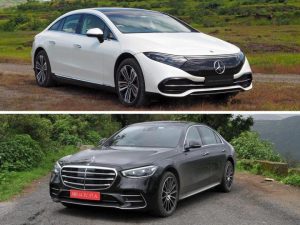
The body of the EQS is more streamlined, with a sleeker profile – but the two are very close in size and otherwise, with the main difference (other than its electric drivetrain) being that the EQS costs several thousand dollars less to start than its S-Class sibling: $104,400 to start for the rear-wheel-drive (and single motor) EQS 450 vs. $111,100 for the S 500. (A top of the line EQS 580 – which has dual motors and so is AWD – stickers for $125,900 vs. $117,700 for the V8-powered S580).
This is not just unusual. It is contrary.
Other electrified versions of engine’d vehicles cost more – a lot more. For example, the electric version of Ford’s F-150 pickup, the Lightning. It stickers for $48,769 – vs. $36,380 for the base, non-electric F1-50. 
But Mercedes appears to have decided to offer the EQS for less to start than the engine’d S – perhaps to compensate EQS owners for the other costs they’ll pay, in the form of having to spend more time thinking about how far they can drive – and how long they may have to wait before they can drive, again.
These are costs associated with driving an EV rather than the cost of the EV, itself – and they beset every EV, regardless of cost.
What’s New
The EQS is a new model for Mercedes.
Opulent and supremely comfortable.
Accelerates like the Enterprise from Star Trek when it goes into warp.
Maximum potential range (340-350 miles) on a full charge is far enough to make this electric almost as practical to drive as an engine’d car . . . with a caveat.
What’s Not So Good
The caveat is finding a place to instill a full charge – and having the time to wait for it.
Sleeker profile cuts down some on headroom in both rows vs. the engine’d S-Class sedan.
Chief rival – Tesla S – comes standard with substantially more range (405 miles).
As this is an electric car review, we won’t be looking under the hood – where’s there’s nothing to see as far as what propels the car. In between the wheels, you will find one or two electric motors, depending on which variant of the EQS you’re looking at.
The rear-drive EQS 450 has one motor driving the rear wheels, directly – as is generally the case with all modern modern electric vehicles. There is no transmission and so no gears and no shifts. The motor spins, the wheels turn. It’s similar with the EQS 580 except there are two motors, one in between the rear wheels and another one up front.
This is how you get all-wheel-drive in an electric car.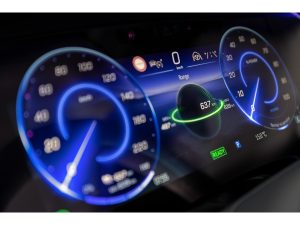
The single engine’d EQS 450 is rated as delivering 329 horsepower and 417 ft.-lbs. of torque. The dual-motor’d EQS 580 ups the output to 516 horsepower and 631 ft.-lbs. of torque.
Interestingly, both versions of the EQS come standard with the same 108 kWh battery pack, so you don’t have to pay extra to get a stronger battery. Also interestingly, you get more advertised range (350 miles) with the base EQS 450. The EQS claims a 340 mile maximum range on a full charge. This runs contra the usual when it comes to electric vehicles – where it’s usually the case that you have to pay more to get more range.
Instead, you get what is usual – with non-electric cars – when you pay extra. That being more power and higher performance.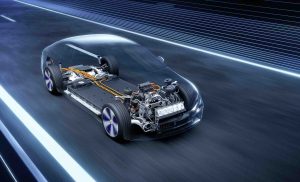
The EQS can go a little farther, because it is lighter – having one less motor. But it is also a little slower, because it has less power. This version of the EQS takes 5.9 seconds to get to 60 MPH. This is a little off the pace of the non-electric S 500 sedan, which is powered by a 3.0 liter inline six/mild hybrid drivetrain that produces 429 horsepower and 384 ft.-lbs. of torque – enough power to get the 4,740 lb. Benz to 60 in just 4.5 seconds.
The EQS 450 weighs 5,597 lbs. – which explains the disparity in quickness. Also, to some extent, range. The non-electric S 500 can travel 464 miles in city driving and 663 miles on the highway (the latter on par with the range of a Toyota Prius hybrid).
The EQS 580 overcomes weight – 5,888 lbs. – with power, getting to 60 in 4.1 seconds, almost as quickly as the non-electric S 580 sedan, which is powered by a 4.0 liter V8/mild hybrid drivetrain that produces 496 horsepower and 516 ft.-lbs. of torque. Both figures are lower than the rated output of the EQS 580’s dual-motor drivetrain but the S580 weighs weighs 4,775 lbs., almost exactly the same as the single-motor’d EQS 450.
The extra 1,000-plus pounds the EQS 580 is lugging around also helps account for the car’s modest range – relative (again) to its non-electric counterpart, which can still go 353 miles in city driving and 552 miles on the highway, both figures significantly higher than the range estimates of the single-motor’d EQS 450.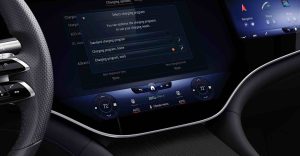
Recharging the EQS is possible three ways, as is usually the case with electric vehicles. You can plug the car into a standard 120V household outlet, which will generally add 20-40 miles of range overnight, depending on how cold it is and whether you park the car inside or outside. In very cold weather, you may find very little range has been added even when the car has been left plugged in all night.
Because in very cold weather, the car is losing charge as it is being charged.
Your next option for at-home charging is plugging into a 240V outlet, but you may have to get an electrician to wire this up for you unless your home was built with a 240V outlet in a place that’s close enough to plug into. Using this method, you can recover a significant charge in a few hours and a full charge in 11 hours.
Or you can “fast” charge – but not at home, as few, if any, private homes have the capacity to deliver the very high voltage electricity that is generally available only at commercial “fast” chargers – which can be likened to commercial gas pumps in that you must drive to them to pump in the power. But there is an important difference. Unlike gas pumps, which all pump gas at more-or-less the same rate, “fast” chargers can vary significantly in terms of the amount of electricity they are capable of pumping into an electric car’s battery. Some can instill a significant recharge in about half an hour.
Others take much longer.
Also keep in mind that even at the highest-power “fast” chargers, you can only recover about 80 percent of a full charge. This is a safeguard to prevent damage to the battery and also to reduce the possibility of the battery catching fire. But it means you resume your drive with 20 percent less than the advertised maximum range. That works out to resuming your drive with 280 miles of range (in the EQS 450; 272 in the EQS 580).
It’s not necessarily an issue, if you don’t need to drive as far as that. Or if you have the time to wait for a full charge.
However, it is an issue if you do need to drive as far as that – and haven’t got the time to wait in order to be able to drive farther than that.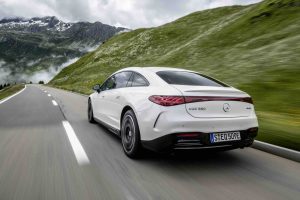
On The Road
If you are viejo enough (or retro enough) to remember the Jetsons, the ’60s cartoon about life in our future, you will recognize the sound made by the EQS when you floor it. If you can focus on it – which is hard to do, especially the first time you floor it because the electric Benz seemingly dilates space and time as it warps forward. That is just the right word to describe what it feels like to jump forward in one of these things. Think of the opening credits scene in Star Trek: Next Generation. Picard says engage – and the Enterprise is gone, in a momentary flash of light.
As you warp, you will hear a sound the Enterprise does not make.
It’s the sound of George Jetson’s flying car. At least, that’s what it sounded like to me. A series of blip-blip-blips, spaced closer-and-closer together. They are not loud, but you can hear them. It’s entertaining and – more to the point – appropriate in that this electric Benz is just that.
When you’re not flooring it, the Benz is what a Benz ought to be. That being dead quiet. You hear only the wind and the road and very little of that unless you’re really listening. Or, just listen to the excellent Burmester audio rig while the seats massage your back. You don’t even have to touch that dial. Just ask the EQS to turn on the massagers and turn up the volume.
The hair in the soup is having to be mindful of the range – and having the time to recharge. I went into some detail about what that is like here but the gist of it is that even the advertised maximum range isn’t much – relative to a non-electric equivalent – and it becomes less if it’s cold out or you’re driving at warp speed. It even becomes less if the car is just sitting, a thing specific to EVs, which lose charge when parked (especially if it is very cold and they are parked outside) and not plugged in, to counteract this loss of charge – which can be as much as 10 or even 20 miles of whatever the range was when you parked it.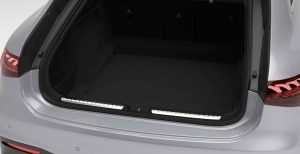
On the upside – as regards the EQS – the indicated range more closely approximates how much range you have left after you drive wherever you were going. Several other EVs this writer has tested were optimistic by as much as 20 percent. However – at least in very cold weather – you will likely discover that (as an example) 170 miles of indicated range when you started leaves you with about 95-100 miles indicated after you have driven 50 actual miles.
And 95-100 miles indicated isn’t much of a margin at that rate of discharge.
The car does have a “fast” charger locator – and a real-time street-view map guidance system to get you there. But Mercedes has no control over where these “fast” chargers are, nor how “fast” (or not) they charge. The good news is that once you’re plugged in there, you’ll be inside one of the nicest waiting rooms you could hope to find.
At The Curb
The EQS is 207.3 inches long overall, which is just a bit shorter than its S Class non-electric sibling, which is 208.2 inches long overall.
Other than that – and the more lozengey shape of the EQS – the main differences between these two Benzes are inside, where there’s an entirely flat “Hyperscreen” screen dash/center stack in the EQS – it looks like Geordi LaForge’s control panel on the Enterprise – vs. the more conventional layout in its non-electric sibling, which still has a separate main gauge cluster and a tablet-style center stack. Optionally available is a similar 12.3 inch display for the front seat passenger, too.
It is a much richer-looking interior than the bleak-looking interior of a Tesla S, with its single huge tablet off the right of the driver and not much else to look at. The Tesla S is also a significantly smaller car, even though it is Tesla’s top-of-the-line car. It is just 197.7 inches long, which makes it closer to being a mid-sized car (e.g., a Toyota Camry is 192.1 inches long) notwithstanding its six-figure price tag.
There is also one more thing – and it is not a small thing.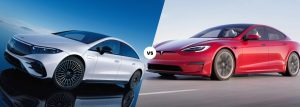
The EQS has almost twice the cargo space as the non-electric S-Class has: 22 cubic feet behind the back seats and 63 cubic feet in total – vs. only 12.9 cubic feet inside the trunk of the S-Class.
This latter is an interesting deficit for a full-size luxury sedan given that 12.9 cubic feet is about as much trunk space as you’d get in a compact-sized economy sedan. It is a function of the fact that the S-Class sedan has an engine up front – and very little in the behind. It is a big car only in between the axle centerlines. Apparently for the sake of looks. In the past big cars had trunks as long as their hoods – and you could fit two or three bodies back there, which is why such cars were prized by mobsters, at least in the movies.
In real life, the big trunk complemented the big interior. If you had three people riding with you, you had room for three people’s bags, too.
You do, again – in the EQS. Because there’s no engine under the hood. And because it has a liftgate rather than a trunk.
As far as what else:
All trims get a panorama sunroof, Burmester audio rig, your pick of 20 or 21 inch wheels, an adaptive suspension and configurable drive settings. The optional Exclusive Package adds a virtual-reality Heads Up Display and the massaging front seats. Massaging rear seats are available along with a rear tablet and neck-shoulder heaters as part of the Executive Package.
The Rest
Mercedes put the plug-in port on the passenger side rear quarter panel. This is a common place to put the fuel door in non-electric cars. But electric car “fast” chargers are sometimes arranged such that you cannot plug in with a car like the EQS unless you back it up, so as to reach the the “pump.”
The 12V power point socket is also in a less-than-convenient place, tucked up almost out-of-sight (and reach) on the front passenger side footwell (as it is in the engine’d S-Class).
The Bottom Line
If the range were more – and the recharge time less – the EQS would likely sell better than the engine’d S-Class. As it is, the EQS is limited by how far it can go – and by how long it takes to get going, again.
. . .
If you like what you’ve found here please consider supporting EPautos.
We depend on you to keep the wheels turning!
Our donate button is here.
If you prefer not to use PayPal, our mailing address is:
EPautos
721 Hummingbird Lane SE
Copper Hill, VA 24079
PS: Get an EPautos magnet or sticker or coaster in return for a $20 or more one-time donation or a $10 or more monthly recurring donation. (Please be sure to tell us you want a magnet or sticker or coaster – and also, provide an address, so we know where to mail the thing!)
My eBook about car buying (new and used) is also available for your favorite price – free! Click here. If that fails, email me at EPeters952@yahoo.com and I will send you a copy directly!





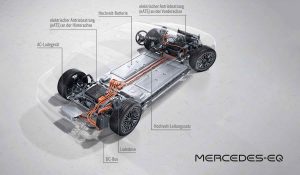








Woman takes 12 hours to get into her Tesla in snow stor, gets visciously attacked by woke trolls:
AmazingPolly
53.4K followers
10 days ago
The Cult of Tesla – Let’s Have Some Laughs at their Expense!
https://rumble.com/embed/v2025x2/?pub=p8j04
Used Tesla Prices Plunge As Demand Evaporates
from zh comments…
The high cost of charging these EV vehicles, not to mention the environmental impact because of electricity generated by coal and gas, the toxic batteries made of environment destroying lithium and cobalt are starting to make gasoline fueled vehicles look like the better and cleaner choice now.
We’re gonna have to flog those ‘artisan miner’ child slaves in the Congo to get them to dig faster… Maybe resurrect King Leopold to get them in line?
The cost of your ‘greenery’ is a blood red scenery in other poor nations, leftites.
Nothing new as Toyota found out the Prius plummeted in value once the batteries needed replacement.
The EV collapse is here. People just are going to drink this kool-aid anymore. The planet doesn’t need saving, CO2 is not a poison and EVs aren’t the replacement for the internal combustion engine you’re looking for.
Tesla’s most valuable asset is the list of customers who sprang for the $13,000 Fraud Self Drive package. These people are a gold mine. They will buy anything.
Go research Chinese black market for “battery recycling” to see where this ends. As more batteries run their course, government mandated recycling programs become very expensive,….. $4500 recycling fee…so you can sell battery to black market at half the price to have buried or dumped in the sea. Hard to tell if the ground contamination or underground fires ultimately cause worse environmental damage?
https://www.zerohedge.com/markets/used-tesla-prices-plunge-demand-evaporates
NYC Electric Garbage Truck Plans Hit Wall After Trucks “Conked Out” Plowing Snow After Just Four Hours……We need them to go 12 hours
The pipe dream of converting the city’s 6,000 garbage trucks from gas to electric ….. the city Department of Sanitation’ has already ordered seven electric rear loader garbage trucks, custom-made by Mack, the report says. Those trucks cost an astonishing $523,000 each and are to be delivered this spring.
https://www.zerohedge.com/markets/nyc-electric-garbage-truck-plans-hit-wall-after-trucks-conked-out-plowing-snow-after-just
you need to start thinking like a politician – instead of buying one truck now you need to buy 3 trucks to do the same job !! 3 times as much kickback as well !! All for the planet right !!
Tesla owners blast Christmas car charging chaos with dozens of electric vehicles forced to wait in THREE HOUR queues at charge stations across the UK
https://www.dailymail.co.uk/news/article-11579649/Tesla-owners-blast-Christmas-car-charging-chaos-dozens-forced-wait-THREE-HOUR-queues.html?ito=social-facebookimage&fbclid=IwAR3LhLSv34HZaQk5aw1-GEIsZq1RQy7S0ucFDJd10O6meKiNkwn2dpOZb6A
The Mercedes EQ reminds me alot of when Cadillac came out with that 8-6-4 motor. You all remember that? It lasted 1 year and I am going to guess this EQ thing lasts about the same.
“Unlike other GM drivetrain snafus of the same era, the response from Cadillac was swift. After attempting 13 software updates with positive improvement in terms of drivability, the 8-6-4 design was quickly retired after a single model year. The L62 was replaced with a smaller 4.1L V8, while those customers who decided to keep their ’81s had the cylinder management system permanently disabled, keeping the engine running on eight cylinders for the remainder of its natural life.”
After reading about the nightmare of an electric car during cold weather I want none of it. But I do like these ultra high fuel economy vehicles like the Audi A2.
EPA city 65 mpg(US)
EPA highway 87 mpg(US)
EPA combined 78.66 mpg(US)
Imagine a car that can get you 70 miles on only 1 gallon. That is real security. They do make them but they do not sell them to the Amerikan slaves.
https://ecomodder.com/forum/emgarage.php?do=details&vehicleid=3812
Ev’s make up less than 3% of vehicle sales after 13 years on the market (that is a huge market flop…lol),
ATTENTION: and 80+% of former ev owners say they will not buy one again…
I have a question I haven’t seen answered yet, sorry if it was already.
Re: charging in cold. and cold it was for most of us this past week.
You said if charging in the cold, your lucky to get a very small amount of range on 120v, and a little more on 240v, as it appears some of the power goes to keeping the battery warm.
So what happens if you are at low range, park it with no charging avail. and it’s cold.
In other words, the battery runs out of charge overnight trying to keep the battery warm.
What happens to the battery if there is no charge avail. and it runs out, in the cold?
EV charging in the US is broken — can Joe Biden fix it?
https://www.theverge.com/22419150/ev-charging-us-joe-biden-infrastructure-plan
Study Shows Electric Cars Become Practically Useless In Cold Weather
https://anewspost.com/electric-cars-useless-in-cold-weather/
One in four public electric vehicle charging stations in the San Francisco Bay Area does not work
https://www.breitbart.com/environment/2022/05/08/report-1-in-4-electric-vehicle-charging-stations-in-san-francisco-dont-work/
The Sonderkraftfahrzeug (SdKfz) 222 was a WW2-era lightly armored reconnaissance vehicle. It was manufactured by Auto Union (direct predecessor to Audi). It weighed 10,600 lbs, had a 3.8L V8 engine that produced 89hp, and had a range of 220 miles (350 km). Manned by a crew of 3: commander, gunner, and driver. The main armament was a 20mm kampfwagenkanone (KwK). It was 189 inches long, 79 inches wide and 67 inches in height. Top speed was 50 mph (80km/h) on the road and 25 mph (40km/h) cross country.
Business idea: Personal EV manager. More than just a chauffeur, “your man” (as Jay Leno speaks of in his antique steamer owner’s manuals) to keep track of your EV fleet (you do have more than one, right?). Ideally, a newly arrived refugee to make sure they are always charged and ready for your adventures. Need more range? He can actually drive for you, then dropping you off and then takes off to track down the nearest EV charger to top up the range.
Here’s the twist. The actual human is employed by a service, not you. So you’ll just pay one monthly fee instead of having to feed and clothe your “man,” nor will you need to worry about Boxing Day or other niceties. That’s all up to the service’s HR department, such as it is. So you can be the spoiled narcissist rich girlie-boy you’ve always wanted to be without it weighing on your conscience. When it is discovered the new arrival doesn’t have proper documentation or is a drunken bum, well, that’s on the service, not you!
I gotta call Kleiner-Perkins…
In other words, a great car, if you don’t need a car?
‘But electric car “fast” chargers are sometimes arranged such that you cannot plug in with a car like the EQS unless you back it up, so as to reach the the “pump.”’ — eric
Mean old physics just won’t stop kicking sand in our faces. High amperage DeeCeeeeeee current heats up the cables, producing line losses. So those cables need to be kept as short as possible, from an efficiency point of view (as opposed to convenience).
Otherwise, some of those electrons you’re paying for just produce waste heat … enough to require water cooling of the cables in the Enterprise-class 500 kW warp-speed chargers (which I suppose might explode a few batteries, by cramming electrons down the poor EeeVeeee’s gullet like a foie gras goose).
Noticed yesterday that the newest charging station in the nearby market town is branded as APS, the public utility. In the overall picture of reckless, gov-mandated malinvestment in EeeVeeees, underutilized charging stations are small potatoes. Probably utilities won’t be bankrupted from dipping their toes in the water — as EeeVeeee makers will be, when the herd of brainwashed buyers finally balks, bellows and defecates in distress instead of climbing into the cattle chute built for them. Paging Temple Grandin!
Still, though, as an electric rate payer, I object like hell to subsidizing the twerps and toffs who drive these infernal coal-fired machines.
“Mean old physics just won’t stop kicking sand in our faces.” – Jim H.
Not just physics, but chemistry and economics too. Doesn’t anyone realize that up until now anyone in the transporation business was well aware of all the advantages of using electricity for locomotion? Tesla (the man) hit one out of the park when he figured out the three phase AC induction motor. 70-80% efficency at a time of horse-drawn carriages? Yes, please! One moving part and a couple of bearings? It’ll last for decades if not abused. There’s a reason why the French TGVs are electric. And all the ongoing operational costs of maintaining a gasoline distrubution network vs an electrical grid? All those pipelines, fuel trucks, trains and storage tanks? Replaced by copper conductors? Sign me up! Not to mention all the new infrastructure becomes a capitalized cost, with all the great tax deductions and accelerated depreciation schedules. Pay one tech per X number of charging stations to maintain them (which is probably just going to be rebooting controllers and replacing vandalized parts), vs one driver per fuel truck who must be trained on spill prevention, maintain CDL and other licenses and therefore commmands a premium salary. And a few people (or AI bots) at a national NOC to monitor for alarms and dispatch the techs. Instead of having a trained tech to repair an ICE, just have some GED tech swap out the motor or control box or whatever until it runs again and send the bad stuff back to the factory for refurbishing.
This is the big reason for all this activity. Get rid of working class and you’ll increase margins. If only someone would get that pesky battery problem figured out.
there is a few problems with switching to 100% EV’s…..
EV’s are 25% efficient because electricity doesn’t come out of a wall plug….AC induction motor. 70-80% efficiency….haha…at the wall plug….
Pushing EV’s will crash the grid, there is no way the grid can supply the power to charge these EV’s, the grid capacity and power generation supply has to be increased 500% to meet the demand. ….for how much? $25 trillion….there is no money to do that….
The opposite is happening, reliable power generation for the grid from gas, coal, oil and nuclear is being shut down….it is getting worse…
In truth, the nation’s power grid is already on its last legs. It has been for years. In a sobering piece for Smithsonian Magazine, Dr. Massoud Amin, a professor of Electrical and Computer Engineering (ECE) at the University of Minnesota, explained the many ways in which the country’s power grid, “the most complex” one ever assembled, could fail.
just doing neglected, deferred maintenance on the existing grid is estimated at $5 trillion…there is no money even for the deferred maintenance….how will you charge more EV’s?
no money?………
El Salvador’s President Nayib Bukele says….. “There’s plenty of money to go around if politicians didn’t steal it”
charging station real estate….
“If you’ve got cars coming into a petrol station, they would stay for an average of five minutes. If you’ve got cars coming into an electric charging station, they would be at least 30 minutes, possibly an hour, but let’s say its 30 minutes.
So that’s six times the surface area to park the cars while they’re being charged. So, multiply every petrol station in a city by six. Where are you going to find the place to put them?”…..there is no real estate…room…..to put these huge charging stations…..
a Level 3 charger has a complicated, expensive cooling system, it will cost between $30,000 and $80,000. plus installation costs, plus huge maintenance costs, so maybe $40,000 to $90,000 installed for one charger, NOTE: plus huge ongoing maintenance costs, is that why 30% don’t work?
these batteries are lasting around seven years…so the lifespan of an EV will be 7 years….old ice cars could last 40 plus years or more….
old mechanical cars like the steam powered cars could last 100 years…
The steam engine goes 600,000 miles without an overhaul, this is better then most gas ice engines.
NOTE RANGE: Steam powered vehicle 1500 mile range on 17 gallons of water, they are the king of range better then ice. BEV has a very short range,
A steam engine burning hydrogen is zero % emission, an EV is remote high emissions at a coal burning power plant.
A modern steam engine here……it is 60% efficient
https://cyclonepower.com/#
new charging stations don’t work in the cold….lol
Brand new Electricity America charging stations don’t work in the cold.
EV charging stations have a very complex cooling system…maybe they need more antifreeze….lol
https://www.reddit.com/r/conspiracy/comments/zui0si/brand_new_electricity_america_charging_stations/
a Level 3 charger has a complicated, expensive cooling system, it will cost between $30,000 and $80,000. plus installation costs, NOTE: plus huge maintenance costs,……gas pumps don’t…..
all the ongoing operational costs of maintaining a gasoline distrubution network….already in place….but….no $25 trillion to upgrade the grid to replace it with EV charging stations
hey Eric, hope you had a good Christmas.
Not really EV related but refuelling with an “app”. Dont know if you have this in the US but Shell here has an app which you can use to refuel at the pump. I set it up ages ago because I got some good offers. Anyhow yesterday after ages used the app to re-fuel- after I did so, it proudly told me how much sin my re-fuel had committed in terms of CO2 emissions !! It then “offered” me if I would like to “find out more” and pay some penance and “offset” it. WTF !! I guess looking at what the EU parliament just passed, it wont be optional for long !!